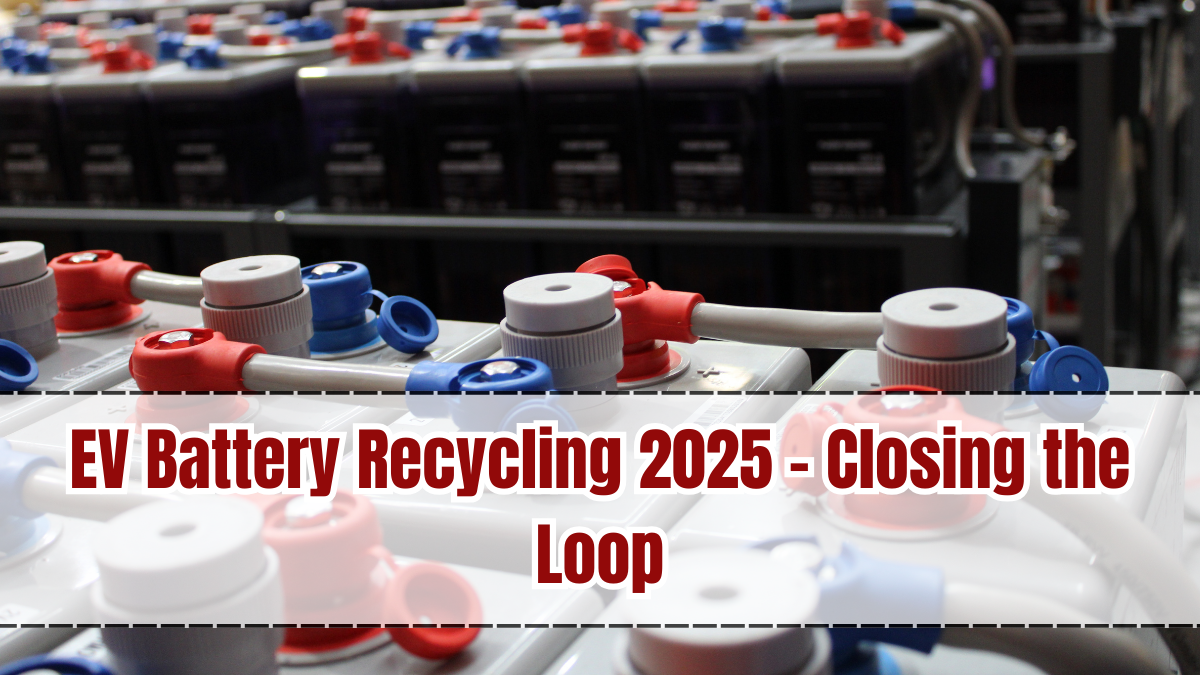The rapid adoption of electric vehicles (EVs) has been a major milestone in reducing carbon emissions, but it has also raised a new challenge: what happens to millions of used EV batteries? By 2025, EV Battery Recycling has become a critical industry, ensuring that valuable materials are recovered and reused while minimizing environmental harm. This practice, often referred to as “closing the loop,” is central to creating a sustainable and circular EV ecosystem.

What is EV Battery Recycling?
EV battery recycling involves collecting, dismantling, and processing used electric vehicle batteries to extract key materials like lithium, cobalt, nickel, and manganese. Instead of letting old batteries end up in landfills, specialized facilities use advanced methods such as hydrometallurgy and direct recycling to recover materials that can be reused in new batteries.
Recycling also focuses on safe disposal of toxic components and reducing dependency on mining, which is both costly and environmentally damaging.
Why It Matters in 2025
The rise of EV Battery Recycling 2025 is driven by multiple factors:
-
The number of EVs worldwide has crossed 250 million units, leading to a surge in battery waste.
-
Mining raw materials is expensive, limited, and harmful to ecosystems.
-
Governments are enforcing stricter regulations on e-waste and battery disposal.
-
Recycled materials lower the production costs of new batteries, making EVs more affordable.
Without recycling, the EV revolution could ironically create another environmental crisis.
Benefits of EV Battery Recycling
The recycling of EV batteries offers enormous environmental and economic benefits:
-
Resource Recovery: Precious metals like lithium and cobalt are extracted and reused.
-
Lower Costs: Reduces the need for new mining, lowering EV production costs.
-
Environmental Protection: Prevents soil and water contamination from battery waste.
-
Job Creation: Recycling plants generate new employment opportunities.
-
Energy Efficiency: Reusing materials requires far less energy than mining raw resources.
This approach ensures that the EV industry remains sustainable in the long run.
Role of Technology
Technology is revolutionizing battery recycling. AI-driven systems sort and dismantle batteries efficiently, while robotic automation reduces human risk in handling hazardous components. Hydrometallurgical processes use environmentally friendly chemicals to recover metals, while direct recycling techniques restore cathode materials for reuse without breaking them down completely. Blockchain is also being tested to track batteries throughout their lifecycle, ensuring transparency and accountability in the recycling chain.
Government and Industry Initiatives
Governments worldwide are treating EV battery recycling as a national priority. The European Union has mandated minimum recycling quotas for battery manufacturers, while the United States and India are funding large-scale recycling plants. Automakers like Tesla, Toyota, and BYD are partnering with recycling companies to build closed-loop supply chains. Startups are also emerging with innovative low-cost recycling solutions, making the industry more competitive and scalable.
Future of EV Battery Recycling
The future looks promising as recycling becomes an integral part of the EV supply chain. By 2030, experts predict:
-
Second-life applications for old batteries in home energy storage.
-
Fully automated AI-driven recycling plants.
-
Global recycling networks that reduce reliance on mining.
-
90%+ recovery rates for key materials like lithium and nickel.
This closed-loop system will ensure that the EV boom continues without exhausting natural resources.
Conclusion
EV Battery Recycling 2025 is not just an industry trend; it is a necessity for the future of sustainable mobility. By recovering valuable materials, reducing environmental risks, and lowering costs, recycling ensures that the EV revolution remains eco-friendly. Governments, automakers, and innovators are working together to close the loop, creating a circular system where batteries live multiple lives. In this way, recycling is powering the green mobility movement forward.
FAQs
What is EV Battery Recycling 2025?
It is the process of recovering and reusing valuable materials like lithium and cobalt from used EV batteries to create new ones.
Why is EV battery recycling important?
It prevents environmental pollution, reduces mining dependency, lowers costs, and supports sustainable electric mobility.
What technologies are used in recycling?
Processes include hydrometallurgy, direct recycling, AI-based sorting, and robotic automation for safe dismantling.
Are old EV batteries completely reusable?
While not all components can be reused, most valuable materials like lithium, nickel, and cobalt can be efficiently recovered.
What is the future of EV battery recycling?
The future includes second-life uses, automated recycling plants, and global supply chains focused on sustainability.
Click here to know more.
